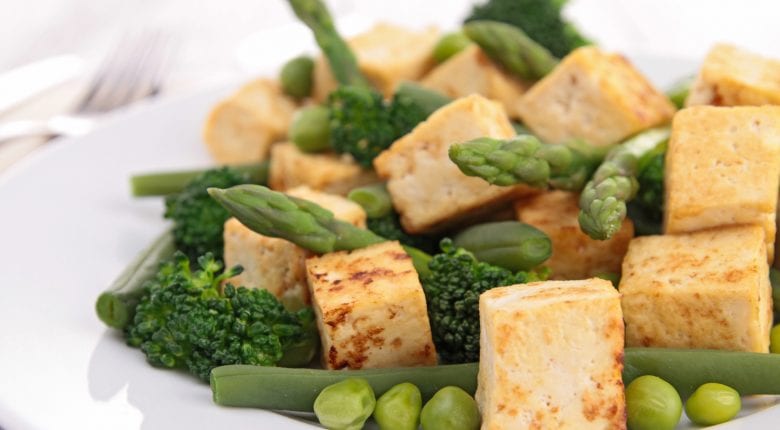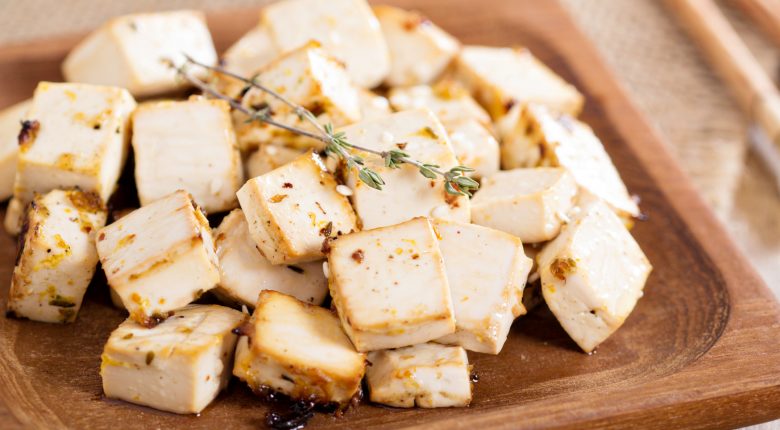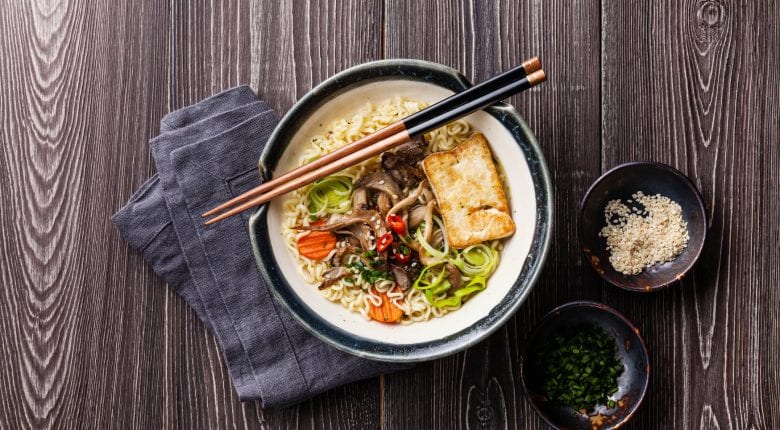Along with soya sauce, tofu is probably one of the best known soya products . This traditionally East Asian food is also conquering the western nations at lightning speed. It may not have any particular taste of its own, but with the right seasoning it can really spice up a dish. Find out to make it as tasty as possible here.
When it comes to tofu, consumers are really quite sceptical. Meat substitute? Made from soya beans? Square? Somehow, a lot of people tend to find the product quite unnatural. Essentially, the basis of this intrigis just vegetables. Or more specifically, soya beans.

From soya beans to tofu
It’s best to start with the production of tofu – sometimes also called bean curd. Once harvested, the soya beans are cleaned, hulled and chopped up. After soaking in water and then straining, soya milk is produced. This is available to us commercially as a plant-based milk substitute. The soya milk produced is mixed with calcium sulphate which then creates a gel. Pressing out then produces the gelatinous and firm consistency.
Some think it can be bland?
When people say “tofu has a boring taste”, there is some reason to this. Tofu hardly has any taste of its own. Some criticism should therefore also be directed at the cook. This is because, whether tofu tastes nice or not, is mainly down to how it is prepared. In fact, the neutral flavour of the soya product can also be a very positive factor. When it comes to preparation and seasoning, you can virtually give free rein to your imagination.
Commercially, tofu comes in three different forms: natural, smoked and seasoned. Which you prefer is a matter of personal taste. In it’s natural form it contains no flavouring components and can therefore be used not just for savoury dishes, but also for sweet dishes (e.g. for a vegan cake filling). When smoked it is particularly good for frying due to its smoky aroma and its savoury flavour. It is very popular among vegetarians as a meat substitute.

Tofu = meat substitute?
Speaking of meat substitutes, tofu is probably best known to most people as a vegetarian product because it is frequently used in place of meat in vegetarian meals such as stews or fried dishes. Increasing numbers of plant-based substitute products are also appearing on the market in the form of tofu sausages and similar. It is worth pointing out in this case that, in its natural or smoked form, tofu lacks one thing in particular – the correct consistency. The product doesn’t have the fibres which we are of course familiar with from meat products.
It’s all in the spices!
Despite all this, tofu can be turned into a real savoury treat by adding spices which we traditionally associate with meat. A marinade made from smoked paprika, pepper, salt and herbs such as thyme and oregano is ideal, for example.
Tofu, incidentally, should always be marinated without oil because that would prevent the seasoning from really soaking in. If you are a fan of exotic cuisine, you might well enjoy an Asian variant involving coconut milk, ginger, lemon juice, soya sauce or garlic.
Whether marinated or not, the plant-based food can easily be cooked, roasted, fried, or even eaten raw, as part of the dish. All kinds of shapes are possible too, e.g. sliced, crumbled or cubed. In Asia, tofu is typically served without seasoning so that it takes on the flavour of the dish.
Here’s another practical tip when using tofu. If you don’t use up all of the tofu at once, the food can be simply placed in water and kept in a cool place for a few days.

Why is tofu currently so popular?
It is hardly surprising that tofu is so widespread in Asia. The popular meat substitute originates from China and was produced for the first time 2,000 years ago. It arrived in Japan in the 8th century. The food is now enjoying steadily growing popularity in the west. This is because tofu is known as a good source of high-quality protein. Tofu is also low in fat, calories and is easy to digest. The precipitant added also makes tofu rich in calcium.
But what are the quality criteria to look out for when purchasing tofu? Large amounts of soya beans are grown for the animal feed industry, mainly in South and North America. And as you might already be aware, extensive cultivation in monocultures impacts negatively on people, animals and the environment. We therefore recommend opting for tofu from soya beans grown in Europe and giving preference to organic products from whole food shops or organic food retailers. High-quality organic products are however also increasingly available from the relevant supermarkets.
Tried tofu… but what else is available?
Ever heard of silken tofu? The food with the superbly-sounding name is less similar to the firm tofu we are all familiar with and instead strongly resembles blancmange in terms of its consistency. The reason for the soft form is that the liquid is not pressed out but is instead retained in the tofu when it is made. Its consistency makes it particularly ideal for desserts, soups or smoothies.
#tofu #veggie #vegetarian #plant-based #nutrition #soya #silken tofu #genetic engineering #source of protein #asian